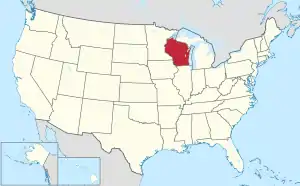Oneida County, Wisconsin
Oneida County is a county in the state of Wisconsin, United States. At the 2010 census, the population was 35,998.[1] Its county seat is Rhinelander.[2]
Oneida County | |
|---|---|
 Oneida County Courthouse in Rhinelander | |
 Location within the U.S. state of Wisconsin | |
 Wisconsin's location within the U.S. | |
| Coordinates: 45°42′N 89°31′W | |
| Country | |
| State | |
| Founded | 1887 |
| Named for | Oneida people |
| Seat | Rhinelander |
| Largest city | Rhinelander |
| Area | |
| • Total | 1,236 sq mi (3,200 km2) |
| • Land | 1,113 sq mi (2,880 km2) |
| • Water | 123 sq mi (320 km2) 10%% |
| Population (2010) | |
| • Total | 35,998 |
| • Estimate (2019) | 35,595 |
| • Density | 29/sq mi (11/km2) |
| Time zone | UTC−6 (Central) |
| • Summer (DST) | UTC−5 (CDT) |
| Congressional district | 7th |
| Website | www |
History
Oneida County was formed in 1887 from sections of Lincoln County.[3] It was named after the indigenous Oneida tribe, one of the five nations of the Iroquois.
Geography
According to the U.S. Census Bureau, the county has a total area of 1,236 square miles (3,200 km2), of which 1,113 square miles (2,880 km2) are land and 123 square miles (320 km2) (10%) are covered by water.[4] Most people visit Oneida County to enjoy its lakes. In particular, tourists flock to Minocqua, a town of nearly 5,000 people with a summer population around 15,000.
Adjacent counties
- Forest County - east
- Langlade County - southeast
- Lincoln County - south
- Price County - west
- Vilas County - north
Major highways
 U.S. Highway 8
U.S. Highway 8 U.S. Highway 45
U.S. Highway 45 U.S. Highway 51
U.S. Highway 51 Highway 17 (Wisconsin)
Highway 17 (Wisconsin) Highway 32 (Wisconsin)
Highway 32 (Wisconsin) Highway 47 (Wisconsin)
Highway 47 (Wisconsin) Highway 70 (Wisconsin)
Highway 70 (Wisconsin)
Airports
Oneida County is served by two public-use airports:
- Rhinelander-Oneida County Airport (KRHI) serves the county and surrounding communities with both scheduled commercial jet service and general aviation services.
- Three Lakes Municipal Airport enhances county general aviation service.
Dolhun Field Airport is also located in the county, but it is for private use by the members of the Dolhun Field Airpark Owners Association.
National protected area
- Nicolet National Forest (part)
Demographics
| Historical population | |||
|---|---|---|---|
| Census | Pop. | %± | |
| 1890 | 5,010 | — | |
| 1900 | 8,875 | 77.1% | |
| 1910 | 11,433 | 28.8% | |
| 1920 | 13,996 | 22.4% | |
| 1930 | 15,899 | 13.6% | |
| 1940 | 18,938 | 19.1% | |
| 1950 | 20,648 | 9.0% | |
| 1960 | 22,112 | 7.1% | |
| 1970 | 24,427 | 10.5% | |
| 1980 | 31,216 | 27.8% | |
| 1990 | 31,679 | 1.5% | |
| 2000 | 36,776 | 16.1% | |
| 2010 | 35,998 | −2.1% | |
| 2019 (est.) | 35,595 | [5] | −1.1% |
| U.S. Decennial Census[6] 1790–1960[7] 1900–1990[8] 1990–2000[9] 2010–2019[1] | |||

At the census[10] of 2000, 36,776 people, 15,333 households, and 10,487 families resided in the county. The population density was 33 people per square mile (13/km2). The 26,627 housing units averaged 24 per square mile (9/km2). The racial makeup of the county was 97.71% White, 0.33% Black or African American, 0.66% Native American, 0.30% Asian, 0.05% Pacific Islander, 0.21% from other races, and 0.75% from two or more races. About 0.66% of the population was Hispanic or Latino of any race. The ancestry of the population was around 44.4% was of German, 8.8% Polish, 7.9% Irish, 5.2% Norwegian, and 5.2% English.
Of the 15,333 households, 27.00% had children under the age of 18 living with them, 57.80% were married couples living together, 7.10% had a female householder with no husband present, and 31.60% were not families. About 26.40% of all households were made up of individuals, and 12.00% had someone living alone who was 65 years of age or older. The average household size was 2.34 and the average family size was 2.82.
In the county, the population was distributed as 22.30% under the age of 18, 5.70% from 18 to 24, 26.50% from 25 to 44, 26.80% from 45 to 64, and 18.70% who were 65 years of age or older. The median age was 42 years. For every 100 females, there were 99.20 males. For every 100 females age 18 and over, there were 97.30 males.
In 2017, there were 324 births, giving a general fertility rate of 66.2 births per 1000 women aged 15–44, the 24th highest rate out of all 72 Wisconsin counties.[11]
Communities
City
- Rhinelander (county seat)
Census-designated places
- Lake Tomahawk
- Minocqua
- Three Lakes
- Woodruff
Unincorporated communities
- Clearwater Lake
- Clifford (partial)
- Crescent Corner
- Enterprise
- Gagen
- Gary Post
- Goodnow
- Harshaw
- Hazelhurst
- Jennings
- Lennox
- McCord
- Malvern
- Monico
- McNaughton
- Newbold
- Pelican Lake
- Pratt Junction
- Rantz
- Roosevelt
- Sugar Camp
- Starks
- Sunflower
- Tripoli (partial)
- Woodboro
Ghost towns/neighborhoods
Politics
| Year | Republican | Democratic | Third parties |
|---|---|---|---|
| 2020 | 56.6% 13,671 | 41.8% 10,105 | 1.6% 383 |
| 2016 | 56.4% 12,132 | 37.7% 8,109 | 6.0% 1,290 |
| 2012 | 50.4% 10,917 | 48.3% 10,452 | 1.3% 283 |
| 2008 | 43.9% 9,630 | 54.3% 11,907 | 1.8% 390 |
| 2004 | 51.5% 11,351 | 47.5% 10,464 | 1.0% 224 |
| 2000 | 50.4% 9,512 | 44.1% 8,339 | 5.5% 1,040 |
| 1996 | 37.5% 6,339 | 45.0% 7,619 | 17.5% 2,959 |
| 1992 | 35.9% 6,725 | 38.3% 7,160 | 25.8% 4,829 |
| 1988 | 51.9% 8,130 | 47.3% 7,414 | 0.8% 126 |
| 1984 | 59.8% 9,787 | 39.2% 6,417 | 1.0% 165 |
| 1980 | 51.2% 8,602 | 41.7% 7,008 | 7.1% 1,195 |
| 1976 | 49.3% 7,347 | 48.4% 7,216 | 2.4% 353 |
| 1972 | 58.8% 6,811 | 36.8% 4,262 | 4.4% 504 |
| 1968 | 48.6% 5,077 | 42.4% 4,435 | 9.1% 946 |
| 1964 | 37.8% 3,909 | 62.1% 6,431 | 0.1% 15 |
| 1960 | 53.2% 5,676 | 46.6% 4,974 | 0.2% 16 |
| 1956 | 64.9% 6,261 | 34.5% 3,328 | 0.6% 59 |
| 1952 | 61.9% 6,224 | 37.9% 3,808 | 0.3% 30 |
| 1948 | 46.5% 3,729 | 50.9% 4,081 | 2.6% 205 |
| 1944 | 44.1% 3,253 | 55.2% 4,076 | 0.7% 54 |
| 1940 | 40.4% 3,694 | 58.8% 5,375 | 0.8% 77 |
| 1936 | 28.5% 2,294 | 64.7% 5,208 | 6.9% 554 |
| 1932 | 28.8% 1,992 | 65.7% 4,542 | 5.5% 379 |
| 1928 | 54.3% 3,100 | 43.9% 2,504 | 1.8% 103 |
| 1924 | 33.1% 1,769 | 6.1% 324 | 60.9% 3,257 |
| 1920 | 64.9% 2,424 | 22.3% 833 | 12.8% 476 |
| 1916 | 45.2% 1,089 | 43.7% 1,054 | 11.1% 267 |
| 1912 | 36.6% 774 | 33.9% 717 | 29.6% 626 |
| 1908 | 58.9% 1,536 | 26.4% 688 | 14.7% 383 |
| 1904 | 75.5% 1,710 | 16.6% 375 | 8.0% 180 |
| 1900 | 70.3% 1,802 | 27.6% 708 | 2.0% 52 |
| 1896 | 70.6% 1,453 | 27.4% 563 | 2.0% 41 |
| 1892 | 45.2% 1,149 | 51.8% 1,317 | 3.0% 76 |
References
- "State & County QuickFacts". United States Census Bureau. Archived from the original on June 6, 2011. Retrieved January 22, 2014.
- "Find a County". National Association of Counties. Retrieved June 7, 2011.
- "Wisconsin: Individual County Chronologies". Wisconsin Atlas of Historical County Boundaries. The Newberry Library. 2007. Retrieved August 15, 2015.
- "2010 Census Gazetteer Files". United States Census Bureau. August 22, 2012. Retrieved August 6, 2015.
- "Population and Housing Unit Estimates". Retrieved March 26, 2020.
- "U.S. Decennial Census". United States Census Bureau. Retrieved August 6, 2015.
- "Historical Census Browser". University of Virginia Library. Retrieved August 6, 2015.
- Forstall, Richard L., ed. (March 27, 1995). "Population of Counties by Decennial Census: 1900 to 1990". United States Census Bureau. Retrieved August 6, 2015.
- "Census 2000 PHC-T-4. Ranking Tables for Counties: 1990 and 2000" (PDF). United States Census Bureau. April 2, 2001. Retrieved August 6, 2015.
- "U.S. Census website". United States Census Bureau. Retrieved May 14, 2011.
- "Annual Wisconsin Birth and Infant Mortality Report, 2017 P-01161-19 (June 2019): Detailed Tables". Archived from the original on June 19, 2019. Retrieved June 20, 2019.
- Leip, David. "Dave Leip's Atlas of U.S. Presidential Elections". uselectionatlas.org. Retrieved November 9, 2020.
Further reading
- Jones, George O. and Norman S. McVean (comp.) History of Lincoln, Oneida and Vilas Counties, Wisconsin. Minneapolis: H. C. Cooper, Jr., 1924.
External links
- Oneida County website
- Oneida County map from the Wisconsin Department of Transportation

